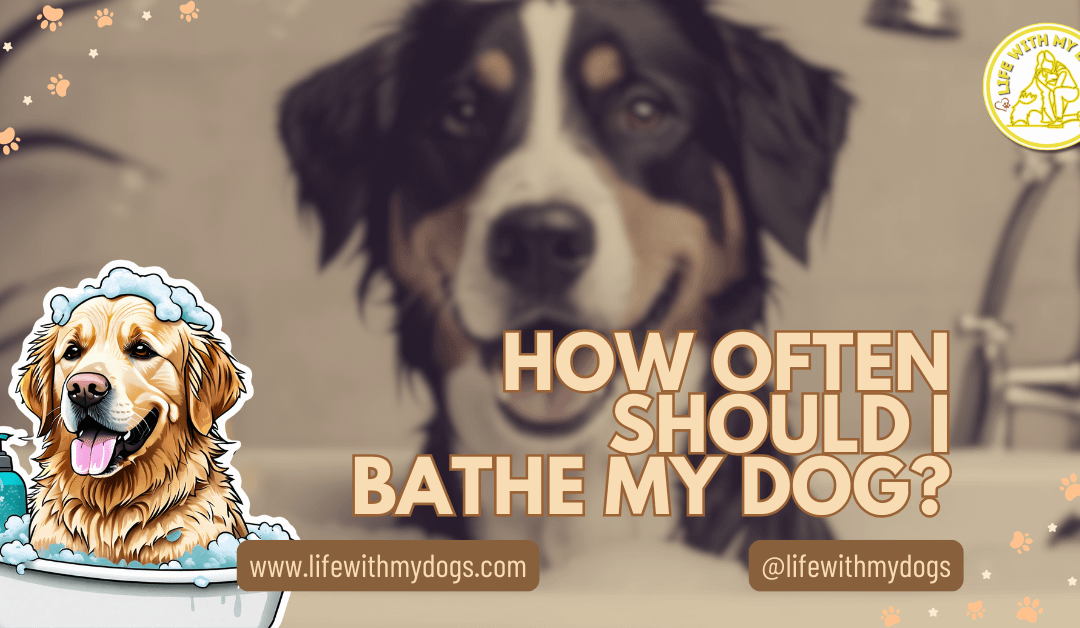LifeWithMyDogs is supported by our audience. When you purchase through one of our links, we may earn a small affiliate commission. As an Amazon Associate I earn from qualifying purchases. Your cost is not affected.
**********
Bathing your dog may seem simple, but getting it right can be tricky. If you’re asking, How often should I bathe my dog? The answer isn’t always straightforward. Too many baths can strip away natural oils, causing dry skin and irritation. However, skipping bath time too often may lead to a smelly pup and potential skin problems. Finding the perfect balance depends on your dog’s breed, coat type, activity level, and unique skin needs. You’re not alone if you’ve ever wondered how often you should bathe your furry friend.
Knowing the right bathing schedule is crucial for your dog’s health and well-being. Whether your dog loves rolling in the mud or prefers lounging indoors, understanding their grooming needs can make a big difference. In this article, we’ll dive into expert recommendations, factors to consider, and tips for a healthy bathing routine that keeps your dog clean without causing harm to their skin. Let’s explore the best approach to keep your pup fresh and happy!
Finding the Right Bathing Schedule for Your Dog: How Often is Too Often?
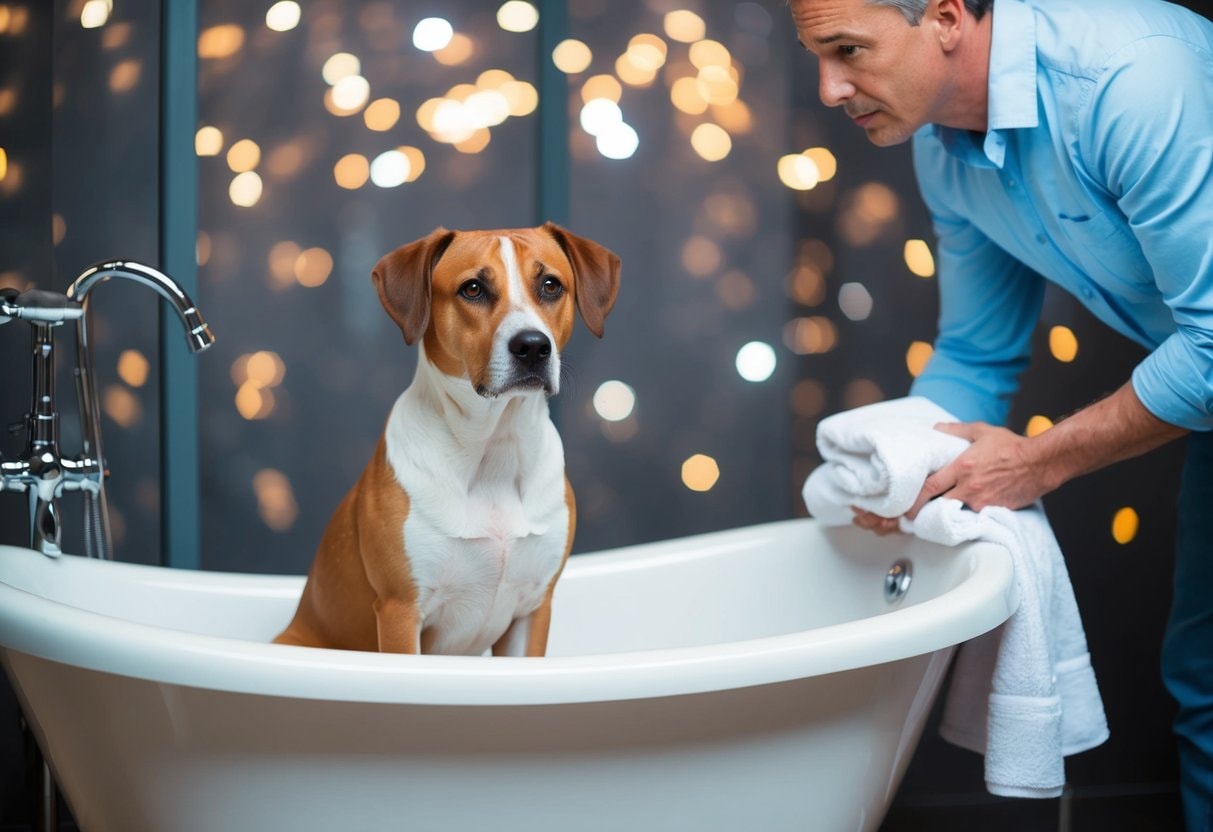
Dogs bring joy and companionship to our lives, but keeping them clean can be challenging. Many pet owners wonder, How often should I bathe my dog? The answer varies depending on your dog’s breed, coat type, and lifestyle, but most dogs typically need a bath every 4-8 weeks. Some dogs may need more frequent baths, while others can go longer between washes, depending on their activities and skin health. Understanding the factors influencing both frequencies is key to keeping your dog happy and healthy without overdoing it.
Your dog’s bathing needs are unique. Active dogs who love to play outside may need more baths to stay clean. Dogs with oily coats or skin issues might need weekly baths. On the other hand, dogs with dry skin or long coats may only need a bath every few months. Regular grooming is more important than frequent baths. Brushing your dog’s coat, cleaning their ears, and trimming their nails can keep them looking and feeling great between baths. Pay attention to your dog’s smell and appearance to know when it’s time for a wash.

Key Takeaways
- Most dogs need a bath every 4-8 weeks, depending on breed and lifestyle.
- Regular grooming is more important than frequent bathing for keeping your dog clean.
- Pay attention to your dog’s smell and appearance to determine when they need a bath.
Understanding Your Dog’s Needs
Bathing your dog depends on several factors unique to your furry friend. Your dog’s breed, activity level, and skin health all play a role in determining the best bathing schedule.

Breed and Coat Type Considerations
Different dog breeds have varying coat types that require specific care. Dogs with medium-to-large coats may need baths every one to six weeks. Short-haired breeds often need less frequent washing. Your Labrador might need monthly baths, while your Poodle could benefit from weekly grooming. Long-haired dogs usually require more frequent baths to prevent matting and tangling. Oily-coated breeds like Basset Hounds may need weekly baths. On the other hand, dogs with water-repellent coats, like Golden Retrievers, shouldn’t be bathed too often to maintain their natural oils.
Assessing Activity Levels
Your dog’s lifestyle affects how often they need a bath. Active dogs who love outdoor adventures tend to get dirtier faster. If your pup enjoys rolling in mud or swimming, you might need to bathe them more often. Dogs that spend more time outdoors may require weekly or bi-weekly baths.
Indoor dogs or less active breeds may only need a bath every few months. You can use your nose as a guide – if your dog starts to smell, it’s probably bath time! Remember to brush your dog regularly between baths. This helps distribute natural oils and keeps their coat healthy.
Recognizing Skin Conditions
Pay attention to your dog’s skin health when deciding on a bathing schedule. If your dog has skin allergies or other conditions, you might need to adjust how often you bathe them. Dogs with skin issues may benefit from more frequent baths with special medicated shampoos. Always consult your vet for the best approach. Watch out for signs of skin problems like:
- Excessive scratching or itching.
- Redness or inflammation.
- Dry, flaky skin.
- Hot spots or sores.
If you notice these symptoms, talk to your vet. They might recommend a specific bathing routine to help manage your dog’s skin condition.

Did You Know?
For dogs with allergies, talk to your vet. They might suggest more frequent baths with medicated shampoo. Some dogs benefit from weekly baths, while others may need less. Follow your vet’s advice for your dog’s specific needs.
Check out this video on how often you should bathe your dog.
By: AnimalWised
Establishing a Bathing Schedule
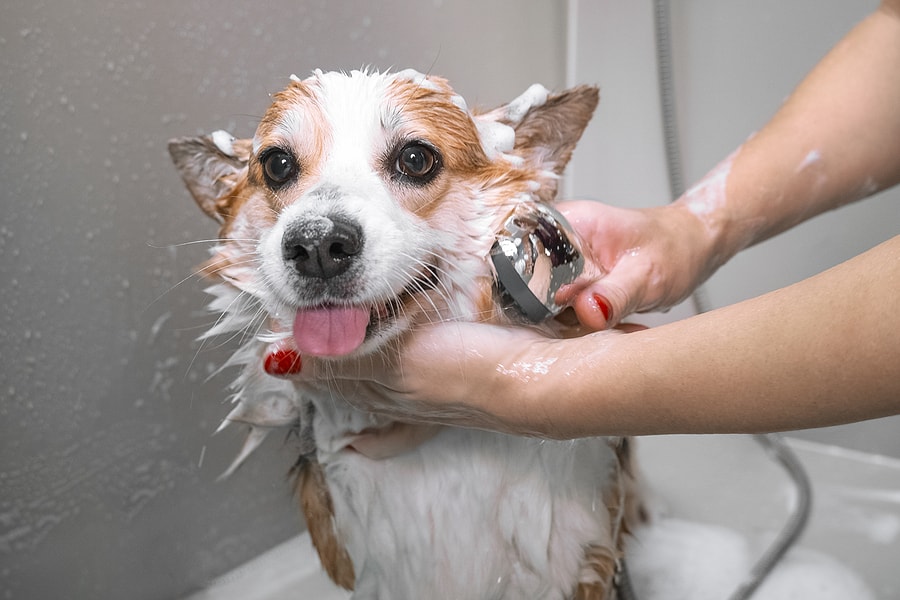
Knowing how often should I bathe my dog helps keep them clean and healthy. A good schedule takes into account your dog’s needs and your lifestyle, ensuring that their coat remains fresh without compromising their skin.
Factors Influencing Bathing Frequency
Your dog’s coat type greatly affects how often they need baths. Dogs with short, smooth coats may only need baths every 4-6 weeks. Long-haired or thick-coated breeds might need more frequent washing. Your dog’s activities matter, too.
They’ll need more baths if they love rolling in mud or swimming. Indoor dogs usually stay cleaner longer. Some dogs have skin issues that affect bathing needs. Talk to your vet if your pup has allergies or other skin problems. The smell test is a good guide. If your dog starts to smell, it’s probably bath time.
Creating a Routine for Your Dog
Pick a regular bath day to help your dog get used to them. This could be every two weeks, monthly, or whatever works for your pup. Make bath time fun with treats and toys. Use warm water and dog-friendly shampoo to keep your dog comfortable. Brush your dog between baths to keep their coat clean and reduce shedding. This can help you stretch out the time between baths. If you’re unsure, ask your vet or groomer for advice. They can help you make a plan perfect for your furry friend.
The Bathing Process
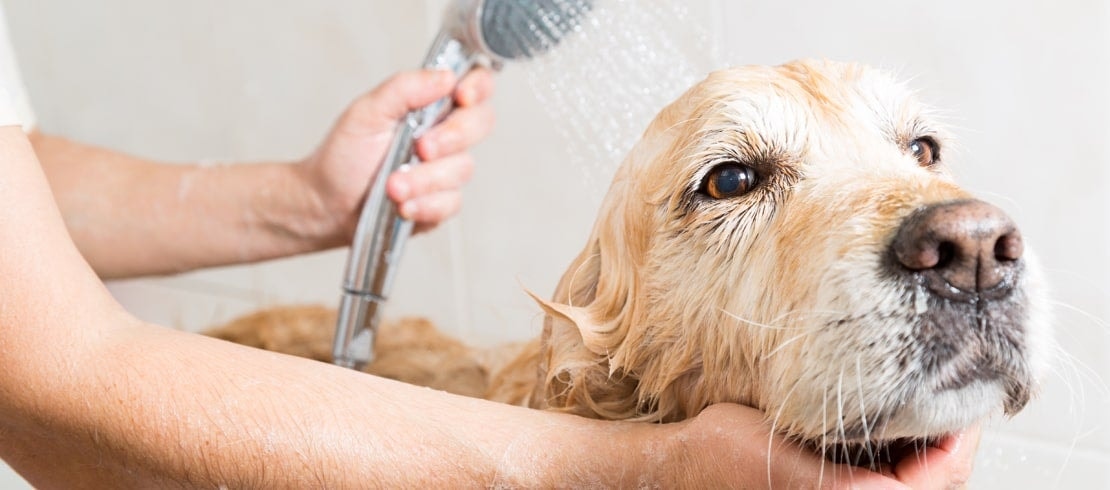
Bathing your dog doesn’t have to be a chore. With the right steps, it can be a fun bonding experience. Here’s how to make bath time easier and more enjoyable for you and your furry friend.
Preparing to Bathe Your Dog
Get everything ready before you start. You’ll need dog shampoo, towels, and treats. Choose a dog-safe shampoo for your pup’s skin and coat. Have a few towels on hand to dry your dog after the bath. Fill the tub with warm water. Not too hot or cold – just right for your dog’s comfort. Put a non-slip mat in the tub to keep your dog from slipping. Brush your dog before the bath. This removes loose fur and tangles. It makes washing easier and more effective.
Step-by-Step Bathing Instructions
Start by wetting your dog’s fur completely. Use lukewarm water and work from the neck down. Be careful not to get water in their ears or eyes. Apply shampoo gently. Start at the neck and work your way back. Don’t forget the belly, legs, and tail. Massage the shampoo into their coat to clean thoroughly.
Rinse well. Make sure all the soap is out. Leftover soap can irritate your dog’s skin. Keep rinsing until the water runs clear. Talk to your dog in a calm, happy voice during the bath. Give them treats to make it a positive experience.
After Bath Care
Dry your dog with a towel. Some dogs love being towel-dried, while others might prefer a gentle pat-down. If your dog doesn’t mind, you can use a blow dryer in a low, cool setting. Brush your dog’s coat while it’s still damp. This helps prevent tangles as the fur dries. It also makes their coat look shiny and healthy.
Reward your dog with treats and praise. This helps them associate bath time with good things. Maybe even give them a new toy as a special post-bath treat. Let your dog have some playtime after the bath. They might want to run around to burn off energy. Just make sure they don’t roll in anything dirty!
How Often Should I Bathe My Dog: Choosing the Right Bathing Products
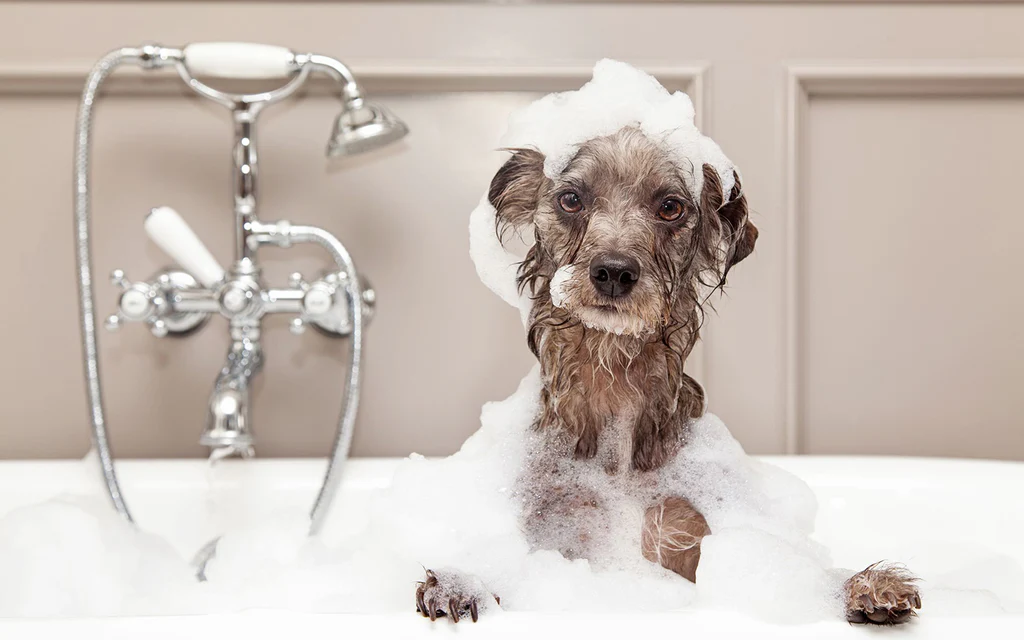
Picking the best products for your dog’s bath time is key. The right shampoo can make a big difference in your pup’s coat and skin health.
Selecting Suitable Dog Shampoo
When choosing a dog shampoo, look for one that matches your pet’s needs. If your dog has dry skin, pick a moisturizing formula. For pups with allergies, try a gentle, hypoallergenic option. Avoid using human shampoo on your dog. It can be too harsh and mess up their skin’s pH balance. Instead, go for shampoos made just for dogs. Look for a special tick shampoo if your furry friend has fleas or ticks. These can help get rid of pests while cleaning your dog’s coat.
The Role of Organic and Specialty Shampoos
Organic dog shampoos are great if you want to avoid harsh chemicals. They often use natural ingredients that are gentle on your pup’s skin and coat. Some dogs need special shampoos for skin issues. These might have things like oatmeal or aloe to soothe itchy skin. If your dog has a specific skin problem, ask your vet about the best shampoo to use.
Medicated shampoos can help with certain skin conditions. Your vet might suggest these if your dog has yeast infections or seborrhea issues. Remember, the right shampoo can improve bath time for you and your dog. It’s worth taking the time to find one that works well for your furry friend.

Special Considerations
Bathing your dog can be tricky in certain situations, especially when you’re wondering, How often should I bathe my dog? Some pups hate water, while older dogs and puppies need extra care. Understanding the right bathing schedule for your dog is key to managing these challenges. Let’s look at handling these situations and ensuring your pup stays clean and healthy without unnecessary stress.
Dealing With Dogs Who Dislike Water
Does your dog run away at bath time? Try these tips:
- Start slow. Let your dog get used to the tub without water first.
- Use treats and praise to make bath time fun.
- Try a shower attachment for gentler water flow.
Keep baths short and sweet. Use warm (not hot) water and speak in a calm voice. For very nervous dogs, try waterless shampoo or grooming wipes between baths. This can help keep them clean without the stress.
Bathing Senior Dogs
Older dogs need extra care during bath time. Their skin may be more sensitive and have trouble standing for long. Here are some tips:
- Use a non-slip mat in the tub to prevent falls.
- Choose a mild, pet-safe shampoo made for sensitive skin.
- Keep baths quick to avoid tiring them out.
You might need to bathe senior dogs more often if they have trouble grooming themselves. But be careful not to dry out their skin. If your old pup can’t stand for long, try spot cleaning with a damp cloth instead of full baths.
Managing Bathing Challenges With Puppies
Puppies are cute, but they can be a handful at bath time. Here’s how to make it easier:
- Start baths early to get them used to it.
- Use lukewarm water and gentle, puppy-safe shampoo.
- Keep sessions short and fun with toys and treats.
Be extra careful around your puppy’s eyes and ears. Use a damp cloth to clean their face instead of pouring water over it. Dry your puppy well after their bath. Puppies can get cold easily. Use a warm towel and maybe even a blow dryer on low heat if they’re okay with it.
Find out the ideal bath schedule for your furry friend in this video on how often to bathe your dog.
By: Doc Ferds Recio
Finding the Right Bathing Routine for Your Dog’s Health and Happiness
In conclusion, finding the right bathing schedule for your dog is essential to maintaining their skin health and overall well-being. While most dogs typically need a bath every 4-8 weeks, factors such as breed, coat type, activity level, and skin conditions can influence how often your dog should be bathed. Paying attention to your dog’s unique needs, whether they are more active, have a particular coat type, or are dealing with skin issues, will help you determine the ideal routine.

Remember, bathing your dog is just one part of their grooming routine. Regular brushing, ear cleaning, and nail trimming are as important to keep your dog clean and comfortable between baths. Understanding your dog’s specific needs and creating a bathing schedule that works for them will ensure they stay fresh, healthy, and happy for years.
Frequently Asked Questions
Dog bathing routines can be tricky to figure out. Here are some common questions about how often to bathe your pup and what factors to consider.

Can I Bathe My Dog Once a Week Without Causing Any Harm?
Weekly baths are usually fine for most dogs. Use a gentle dog-specific shampoo to avoid drying out their skin. If your dog has no skin issues, bathing once a week shouldn’t cause problems.
What Are the Recommendations for Bathing a Short-haired Dog?
Short-haired dogs often need fewer baths. You can wash them every 4-6 weeks. Their coats tend to repel dirt better than longer-haired breeds. Brush them regularly to keep their coat healthy between baths.
Is It Harmful to Bathe My Dog Every Day, and What Could Consequences Be?
Daily baths can harm your dog’s skin. It strips natural oils, leading to dry, itchy skin. This can cause irritation and even infections. Stick to less frequent baths unless advised by your vet.
How Should I Adjust My Dog's Bathing Routine During the Winter Months?
In winter, bathe your dog less often. Cold weather can dry out their skin. Use warm water and dry them thoroughly. Consider waterless shampoos for quick clean-ups between baths.
What Signs Indicate That It's Time to Bath My Dog?
Look for these signs: a dirty or smelly coat, visible dirt or mud, or if your dog has been rolling in something stinky. If you can smell your dog from across the room, it’s bath time. Regular brushing can help extend the time between baths.
Follow Us on Social Media
Become part of a vibrant dog-loving community! Connect with fellow enthusiasts, explore engaging content, and check out our product reviews by following us online!
- Facebook: Life With My Dogs
- Instagram: @LifeWithMyDogs2
- Pinterest: Life With My Dogs
- YouTube: Life With My Dogs

